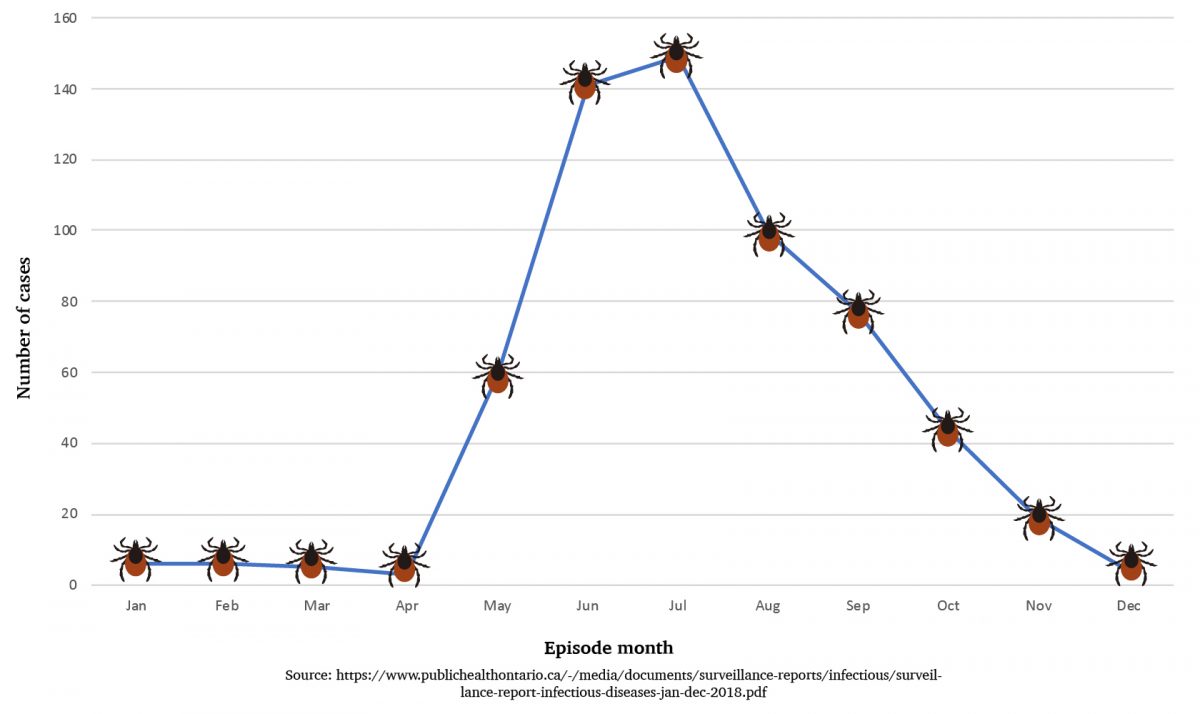You might think you’re only at risk of Lyme disease during the spring and summer. However, it can be contracted whenever ticks are active–and ticks are active any time of year when it’s above freezing and there isn’t snow on the ground.
Erin Edwards, a Toronto photographer, takes pictures on her father’s land in Peterborough, Ont., throughout the year. Edwards says she wasn’t aware Lyme disease posed a threat year-round:
“My dad’s property is known to have lot of blacklegged ticks. I always do a tick check to make sure I haven’t picked up any in the spring and summer. I had no idea that it was even an issue in the winter, which kind of freaks me out because I’ve never done a tick check in the winter.”
Janet Sperling, an expert on ticks and a board member of the Canadian Lyme Disease Foundation, says that Canadians can be exposed to Lyme disease during any season if the weather conditions are right:
“You have times when you have a higher risk and times when you have a lower risk, but there’s never a question that you [don’t] have zero risk. There’s always a little bit of a risk.”
Lyme disease is a bacterial infection spread by the bacterium Borrelia burgdorferi. Ticks contract it when they feed on creatures that can carry the bacterium, such as birds and mice. The infected tick then transmits the disease to humans through its bite. Lyme disease can cause severe symptoms if left untreated, such as Bell’s palsy, heart disorders and arthritis.
Canadians face the highest risk of contracting Lyme disease during the spring and summer. It’s difficult to spot and remove them before they transmit the disease at this time of year because they’re in their nymph stage of life and are about the size of a poppy seed.
However, data from the integrated Public Health Information System supports Sperling’s argument that Lyme disease can be contracted at any time of the year. There were probable and confirmed cases of the infectious disease throughout 2018 in Ontario.
Number of probable and confirmed Lyme disease cases in Ontario by episode month in 2018

Sperling says Canadians are putting themselves in greater danger of contracting the disease during the cooler months:
“People usually think about spring and summer because you’re outside, you’re wearing…shorts and a t-shirt and you’re lying in the grass. But because we’re not paying attention in the fall and winter, often that puts us at an even higher level of risk.”
The blacklegged tick, also known as the deer tick, is the only species of tick in Ontario that can spread Lyme disease. Public Health Ontario mapped parts of the province where these ticks have been found and where humans may come in contact with an infected one.

A map of the estimated risk areas in Ontario for 2019. (Public Health Ontario)
The agency warns, though, that blacklegged ticks feed on migratory birds, so they could potentially be found almost anywhere in the province.
Dr. Curtis Russell, a biologist with Public Health Ontario, said the insect is primarily found in forested areas. However, he cautioned they can be found in the city as well.
“One of our risk areas is along the Rouge National Urban Park system, which is right in Toronto. So you can definitely find them near urban areas,” said Russell. “As long as you have that brushy, wooded area with the right animal host, you can find them there,” he added.
Russell offered tips to help prevent contracting Lyme disease:
- Wear bright clothing outside to see ticks more easily.
- Walk in the middle of trails to avoid vegetation on either side that could carry ticks.
- Tuck your shirt into your pants, as well as your pants into your socks when outdoors. This will force ticks to travel higher up your body to find exposed skin, increasing your time to spot them.
- Wear an insect repellant containing DEET or Icaridin.
- Heat any clothes you wore outside in the dryer for an hour to kill ticks.
- Take a shower or bath after your outdoor activity. It will be easier to check for ticks without clothes on.
Lyme Ontario, a non-profit organization that spreads awareness of Lyme disease, recommends looking in certain areas of the body while checking for ticks. Scroll over the images below to see where ticks are most likely to go.
For more information on Lyme disease, click here.

Amazing images/graphs! Great info. 🙂
Cool article. Informative, articulate and poignant. Very helpful graphics.
Well done!